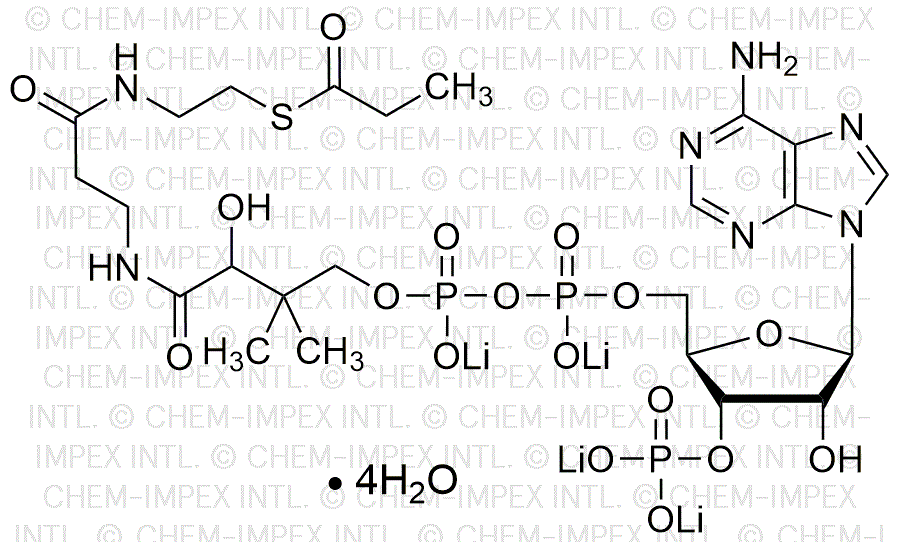Propionyl coenzyme A lithium salt is widely utilized in research focused on:
- Metabolic Studies: This compound plays a crucial role in studying metabolic pathways, particularly in energy production and fatty acid metabolism, helping researchers understand cellular processes.
- Drug Development: It serves as a valuable intermediate in synthesizing pharmaceuticals, particularly in developing medications targeting metabolic disorders, enhancing drug efficacy.
- Biochemical Assays: Used in various assays to measure enzyme activity related to coenzyme A, it aids in understanding enzyme kinetics and regulation in biochemical research.
- Genetic Research: The compound is instrumental in genetic studies, particularly those exploring gene expression related to metabolic enzymes, facilitating advancements in gene therapy.
- Food Industry Applications: It can be applied in food science to study flavor compounds and their interactions, contributing to the development of enhanced food products.
Información general
Propiedades
Seguridad y normativas
Aplicaciones
Propionyl coenzyme A lithium salt is widely utilized in research focused on:
- Metabolic Studies: This compound plays a crucial role in studying metabolic pathways, particularly in energy production and fatty acid metabolism, helping researchers understand cellular processes.
- Drug Development: It serves as a valuable intermediate in synthesizing pharmaceuticals, particularly in developing medications targeting metabolic disorders, enhancing drug efficacy.
- Biochemical Assays: Used in various assays to measure enzyme activity related to coenzyme A, it aids in understanding enzyme kinetics and regulation in biochemical research.
- Genetic Research: The compound is instrumental in genetic studies, particularly those exploring gene expression related to metabolic enzymes, facilitating advancements in gene therapy.
- Food Industry Applications: It can be applied in food science to study flavor compounds and their interactions, contributing to the development of enhanced food products.
Documentos
Hojas de datos de seguridad (HDS)
La SDS proporciona información de seguridad completa sobre la manipulación, el almacenamiento y la eliminación del producto.
Especificación del producto (PS)
La PS proporciona un desglose completo de las propiedades del producto, incluida la composición química, el estado físico, la pureza y los requisitos de almacenamiento. También detalla los rangos de calidad aceptables y las aplicaciones previstas del producto.
Certificados de análisis (COA)
Busque certificados de análisis (COA) ingresando el número de lote del producto. Los números de lote y de partida se pueden encontrar en la etiqueta de un producto después de las palabras "Lote" o "Lote".
Número de catálogo
Número de lote/lote
Certificados de origen (COO)
Este certificado de origen confirma el país en el que se fabricó el producto y también detalla los materiales y componentes utilizados en él y si se deriva de fuentes naturales, sintéticas u otras fuentes específicas. Este certificado puede ser necesario para cumplir con las normativas aduaneras, comerciales y regulatorias.
Número de catálogo
Número de lote/lote
Hojas de datos de seguridad (HDS)
La SDS proporciona información de seguridad completa sobre la manipulación, el almacenamiento y la eliminación del producto.
DownloadEspecificación del producto (PS)
La PS proporciona un desglose completo de las propiedades del producto, incluida la composición química, el estado físico, la pureza y los requisitos de almacenamiento. También detalla los rangos de calidad aceptables y las aplicaciones previstas del producto.
DownloadCertificados de análisis (COA)
Busque certificados de análisis (COA) ingresando el número de lote del producto. Los números de lote y de partida se pueden encontrar en la etiqueta de un producto después de las palabras "Lote" o "Lote".
Número de catálogo
Número de lote/lote
Certificados de origen (COO)
Este certificado de origen confirma el país en el que se fabricó el producto y también detalla los materiales y componentes utilizados en él y si se deriva de fuentes naturales, sintéticas u otras fuentes específicas. Este certificado puede ser necesario para cumplir con las normativas aduaneras, comerciales y regulatorias.


